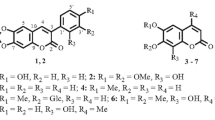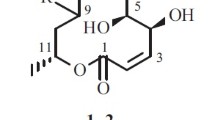9-O-methylfusarubin was isolated from a novel source, Fusarion oxysporum, and evaluated for its phytotoxic and chlorotic inducing properties in plants as well as its potential as an antineoplastic agent. Etiolated wheat coleptiles were inhibited 100 and 40%, respectively, at 10-3 and 10-4 M. Bean plants were necrotic and chlorotic, with leaf malformations, following 10-2 M treatments. Corn plants were chlorotic following 10-3 and 10-4 M treatments. Tobacco plants exhibited subtle interveinal chlorosis with 10-2 M applications. All agrochemical effects were substantial, but transient. The anticancer properties were evaluated using ras transformed liver epithelial cells. Doses ranging from 12.5-50 μM provided a dose-dependent reduction in the number of viable cells when compared to controls. At the 50 μM dose, the number of viable cells was reduced by 65% suggesting potential antineoplastic effects of 9-O-methylfusarubin.
Similar content being viewed by others

Author information
Authors and Affiliations
Corresponding author
Rights and permissions
About this article
Cite this article
Bauer, J., Cutler, H., Hugdahl, J. et al. Biological Evaluation of a Secondary Metabolite, 9-O-methylfusarubin, from Fusarium oxysporum. Med Chem Res 14, 369–381 (2005). https://doi.org/10.1007/s00044-006-0145-3
Received:
Accepted:
Issue Date:
DOI: https://doi.org/10.1007/s00044-006-0145-3



